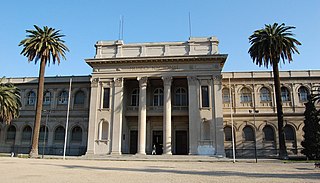
Montevideo is the capital and largest city of Uruguay. According to the 2011 census, the city proper has a population of 1,319,108 in an area of 201 square kilometers (78 sq mi). Montevideo is situated on the southern coast of the country, on the northeastern bank of the Río de la Plata.

The Prado Museum, officially known as Museo Nacional del Prado, is the main Spanish national art museum, located in central Madrid. It is widely considered to house one of the world's finest collections of European art, dating from the 12th century to the early 20th century, based on the former Spanish royal collection, and the single best collection of Spanish art. Founded as a museum of paintings and sculpture in 1819, it also contains important collections of other types of works. The Prado Museum is one of the most visited sites in the world and is considered one of the greatest art museums in the world. The numerous works by Francisco Goya, the single most extensively represented artist, as well as by Hieronymus Bosch, El Greco, Peter Paul Rubens, Titian, and Diego Velázquez, are some of the highlights of the collection. Velázquez and his keen eye and sensibility were also responsible for bringing much of the museum's fine collection of Italian masters to Spain, now one of the largest outside of Italy.

The National Party, also known as the White Party, is a major political party in Uruguay. It was founded in 1836 by Manuel Oribe, making it the country's oldest active political party, and together with the Colorado Party, its origin dates back to the time of the creation of the Uruguayan State.

The National Museum of Anthropology is a national museum of Mexico. It is the largest and most visited museum in Mexico. Located in the area between Paseo de la Reforma and Mahatma Gandhi Street within Chapultepec Park in Mexico City, the museum contains significant archaeological and anthropological artifacts from Mexico's pre-Columbian heritage, such as the Stone of the Sun and the Aztec Xochipilli statue.

The Natural History Museum in Lima, is Peru's most important museum of natural history. It was established in 1918 and belongs to the National University of San Marcos.

The National Archaeological Museum is a museum in Madrid, Spain. It is located on Calle de Serrano beside the Plaza de Colón, sharing its building with the National Library of Spain.

The National Museum of Natural Sciences is the national museum of natural history of Spain. It is situated in the center of Madrid, by the Paseo de la Castellana. It is managed by the Spanish National Research Council (CSIC).

Josephoartigasia is an extinct genus of enormous dinomyid rodent from the Early Pliocene to Early Pleistocene of Uruguay. The only living member of Dinomyidae is the pacarana. Josephoartigasia is named after Uruguayan national hero José Artigas. It contains two species: J. magna, described in 1966 based on a left mandible, and J. monesi, described in 2008 based on a practically complete skull. Both are reported from the San José Member of the Raigón Formation by the Barrancas de San Gregorio along the shores of Kiyú beach.

The Chilean National Museum of Natural History is one of three national museums in Chile, along with the Museum of Fine Arts and the National History Museum. It is located in Quinta Normal Park. Founded on September 14, 1830 by the French naturalist Claudio Gay, the director of the Museum and the Botanical garden was another Frenchman Jean-François Dauxion-Lavaysse.

The Museo de la Estampa is a museum in Mexico City, dedicated to the history, preservation and promotion of Mexican graphic arts. The word “estampa” means works in the various printmaking techniques which have the quality of being reproducible and include seals, woodcuts, lithography and others. The museum was created in 1986 and located in a 19th-century Neoclassical building located in the Plaza de Santa Veracruz in the historic center of the city. This building was remodeled both to house the museum and to conserve its original look.
The Museo Nacional de Historia Natural Cubana or Museo Nacional de Historia Natural de Cuba in Havana, Cuba is the national museum of Natural History, with exhibits of Cuba's plants and animals. It is located in a former U.S. embassy building.
Ana María del Carmen Ribeiro Gutiérrez, known as Ana Ribeiro, is a Uruguayan historian, writer, and professor. Her works are based on essays and novels that relate historical events of the country.
Margarita Musto is a Uruguayan actress, theater director, translator, teacher, and general and artistic director of the Comedia Nacional.

Dumas Oroño was a Uruguayan artist, cultural manager, and teacher. His artistic work spanned several disciplines, including painting, engraving, ceramics, murals, and jewelry design.

Mélica Elisa Muñoz-Schick is a Chilean botanist noted for her work curating the collections of the herbarium at the Chilean National Museum of Natural History, as well as her research into the flora of Chile. The standard author abbreviation Muñoz-Schick is used to indicate this person as the author when citing a botanical name.

Laura Malosetti Costa is a Uruguayan-born Argentine social and cultural anthropologist, researcher, art historian, and essayist. She is also a curator of art exhibitions and the author of several books on Latin American art. She was recognized with the Konex Award in 2006 and 2016.
Héctor Saúl Osorio Rial (1928–2016) was a pediatrician, bacteriologist, and lichenologist from Uruguay.

Rebeca Acevedo was a Chilean professor and botanist. She was the first woman to head the botanical department of the Chilean National Museum of Natural History in 1947.

Eva Díaz Torres was a Uruguayan ceramicist, who specialised in the production of Raku ware. A member of the Tupamaros, she was imprisoned for her political beliefs from 1972 to 1974.

















